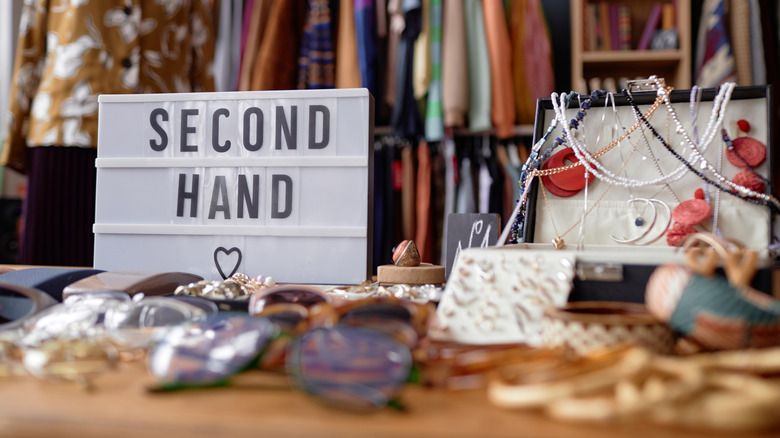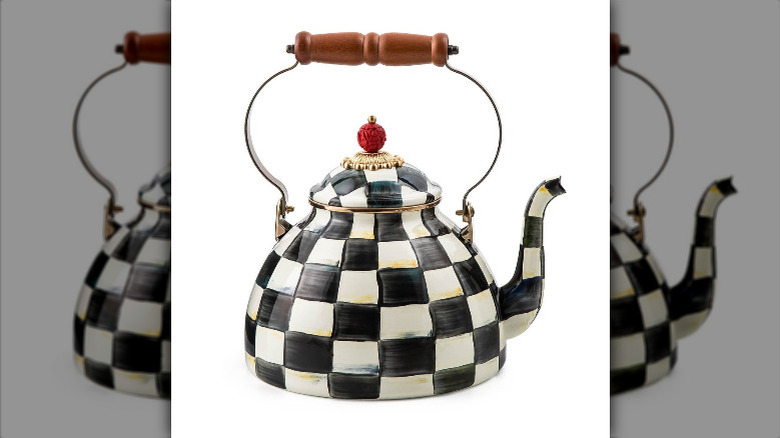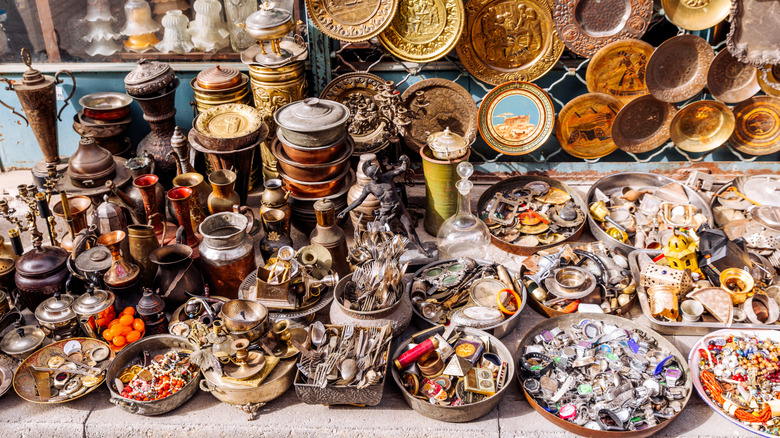The Checkered Vintage Dishware You Should Always Look For When Thrifting
Going to the thrift store can be like a treasure hunt. Whether you're looking for a steal on clothing, a quirky piece of art to hang on your wall, or something for your kitchen, like vintage Pyrex cookware, the quest for the perfect thrift store find can be a thrill in and of itself. And if you're thrifting with kitchenware in mind, keep your eyes out for vintage Mackenzie-Childs pieces — this ceramic and glass dishware, with its bold colors and vivid check pattern, is beloved by collectors, and adds whimsical charm wherever you use it.
While you can buy Mackenzie-Childs kitchenware online today, vintage items are particular favorites, as popular homeware influencer @yours.truly.home showed in a post about finding one of the company's glass cakestands "in the wild" at a thrift store. Moreover, brand new Mackenzie-Childs dishware can be very expensive, with a single piece of cookware potentially costing hundreds of dollars. Finding vintage pieces at a thrift store, then, can be a great way to build your collection for bargain prices.
How Mackenzie-Childs' dishware went from local favorite to collectible treasure
Today, Mackenzie-Childs' dishware is beloved by collectors and design enthusiasts across America, but it used to be one of upstate New York's best-kept secrets. The brand was founded in 1983 by husband and wife duo Victoria and Richard Mackenzie-Childs. It started as a small operation out of the small lakeside town of Aurora, New York with a focus on high-quality dishware, glassware, and ceramics, but by the mid-1990s, a Mackenzie-Childs boutique had opened its doors on Madison Avenue in New York City.
While the best-known Mackenzie-Childs' products include ceramics and glassware featuring their signature black and white "courtly check" pattern, today, the brand also stocks linens, home decor, and even a line of candles. Fans enjoy the whimsical designs, which can lend a retro feel to Mackenzie-Childs dishware that makes them perfect for serving up old-school comfort foods like casseroles, or an afternoon tea complete with a Mackenzie-Childs tiered stand.
Today, Victoria and Richard Mackenzie-Childs are no longer part of the brand, which was acquired by American Girl doll creator Pleasant Rowland in 2001. However, it's still headquartered in Aurora, and hosts an annual "Barn Sale" in the 19th-century barn located on the headquarters' property.
The pros — and potential pitfalls — of vintage dishware
Vintage kitchen items, like Mackenzie-Childs pieces, are making a return in 2025, and there are plenty of benefits to collecting and using them beyond the "thrill of the hunt" at your local thrift store. Many people, and in particular, fans of the popular, nostalgic "cottagecore" aesthetic, which seeks to evoke a cozy, simple lifestyle in the countryside or forest, love the way vintage dishware and kitchenware looks. Some, in fact, find that it makes meals more fun to eat them off their favorite dishes. For the environmentally aware, sustainability is another benefit to shopping vintage, as kitchenware that's already made doesn't contribute to the environmental impacts of new production.
However, if you decide to start collecting and using vintage dishware or cookware, keep a few potential safety concerns in mind. While vintage plates and glassware can be beautiful, not all of them are food safe, as many older plates, cups, and bowls were decorated with lead paint.
Even more seriously, lovers of antique dishware should take note that it's not easy being green, and in fact, could be dangerous. Very old dishware from the 19th century that has been painted green might have used dyes that contain arsenic, like the infamous blue-green "Paris green." If you find a piece that you suspect may contain lead or arsenic at your local thrift store, it should be used only as decoration, not for eating or drinking.


